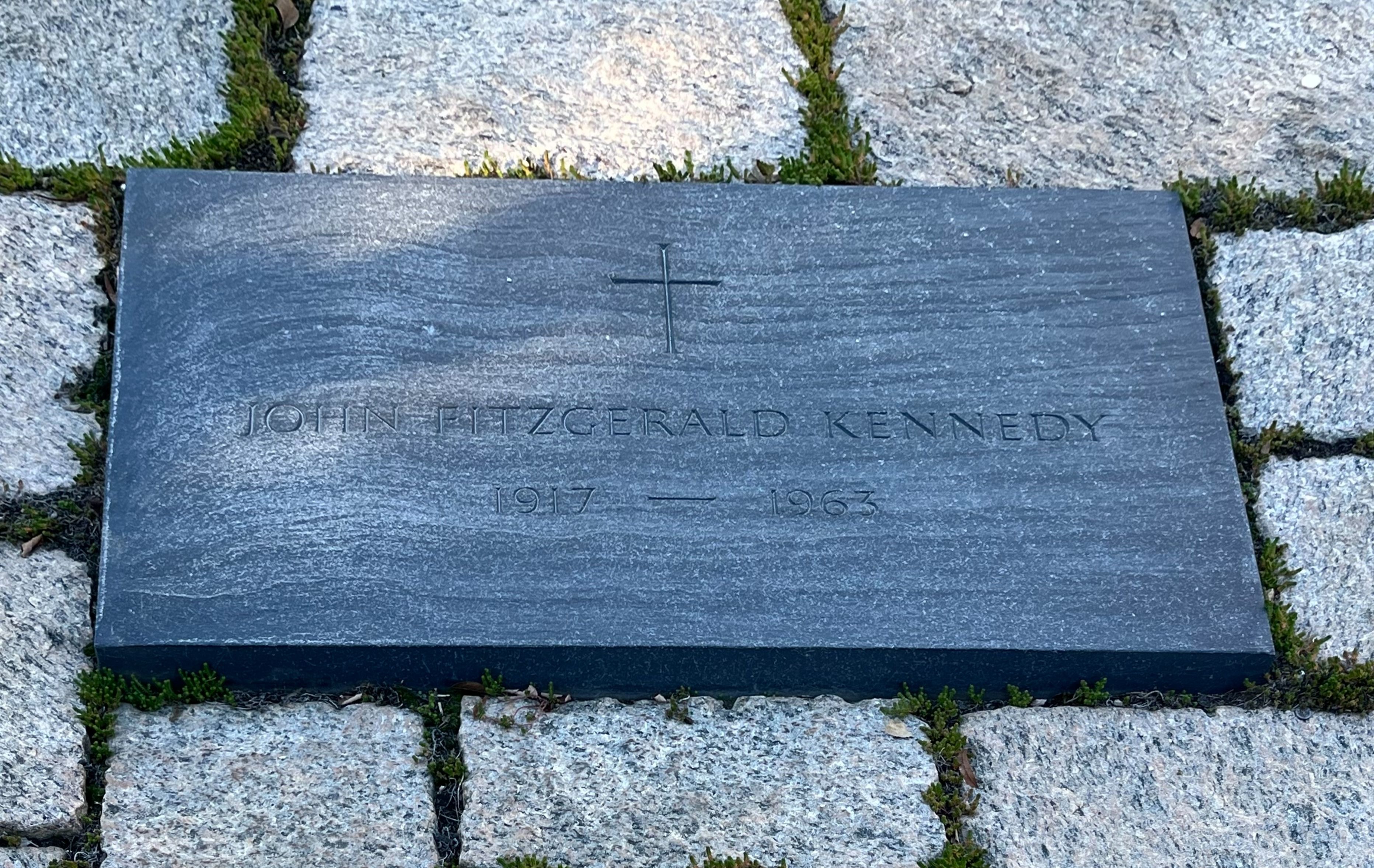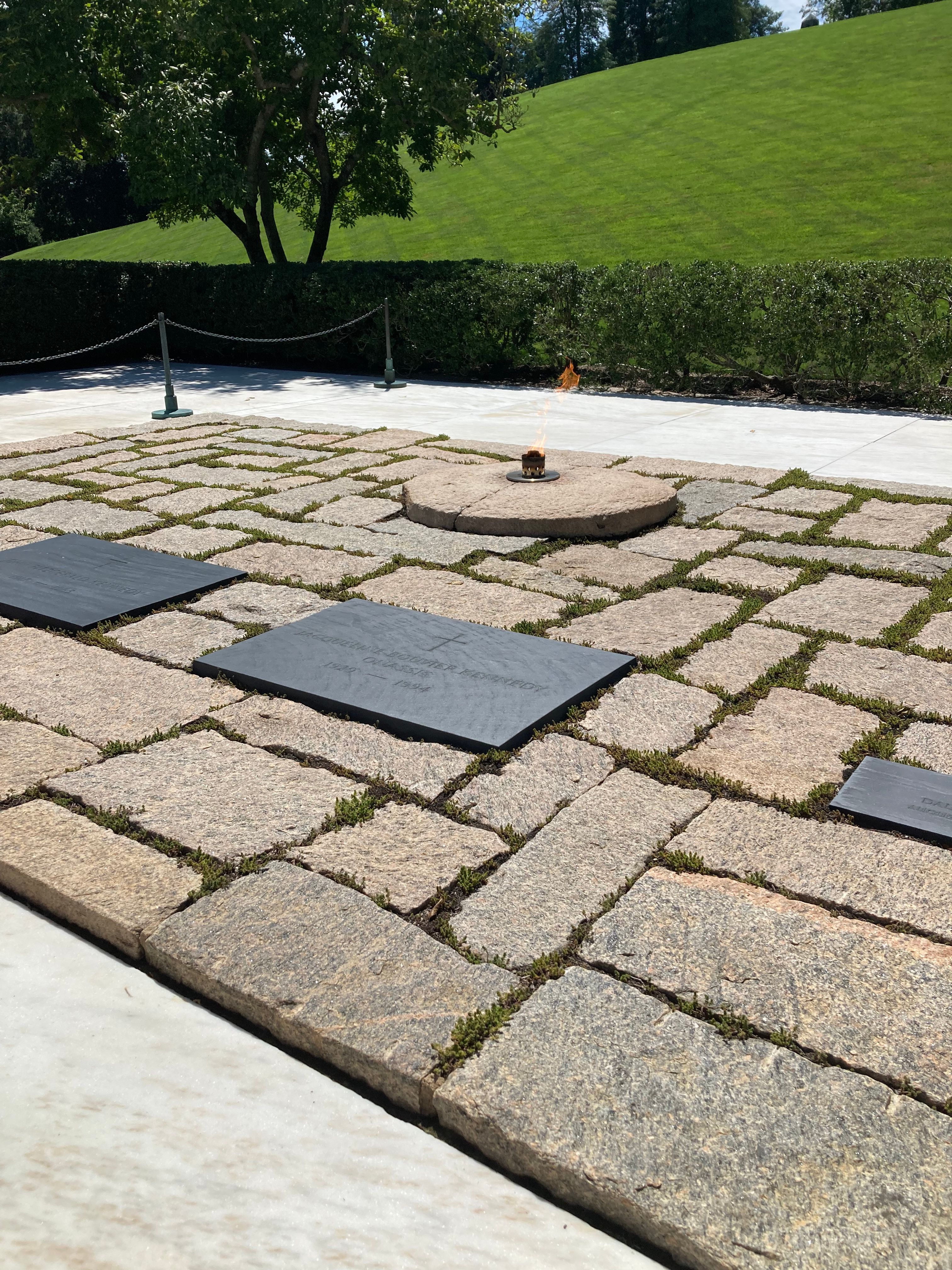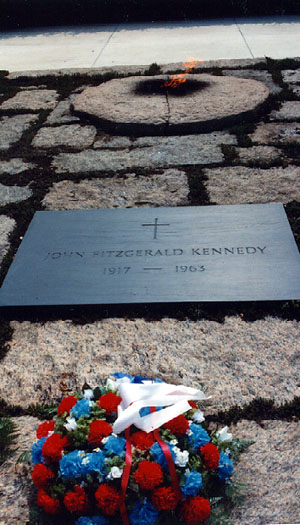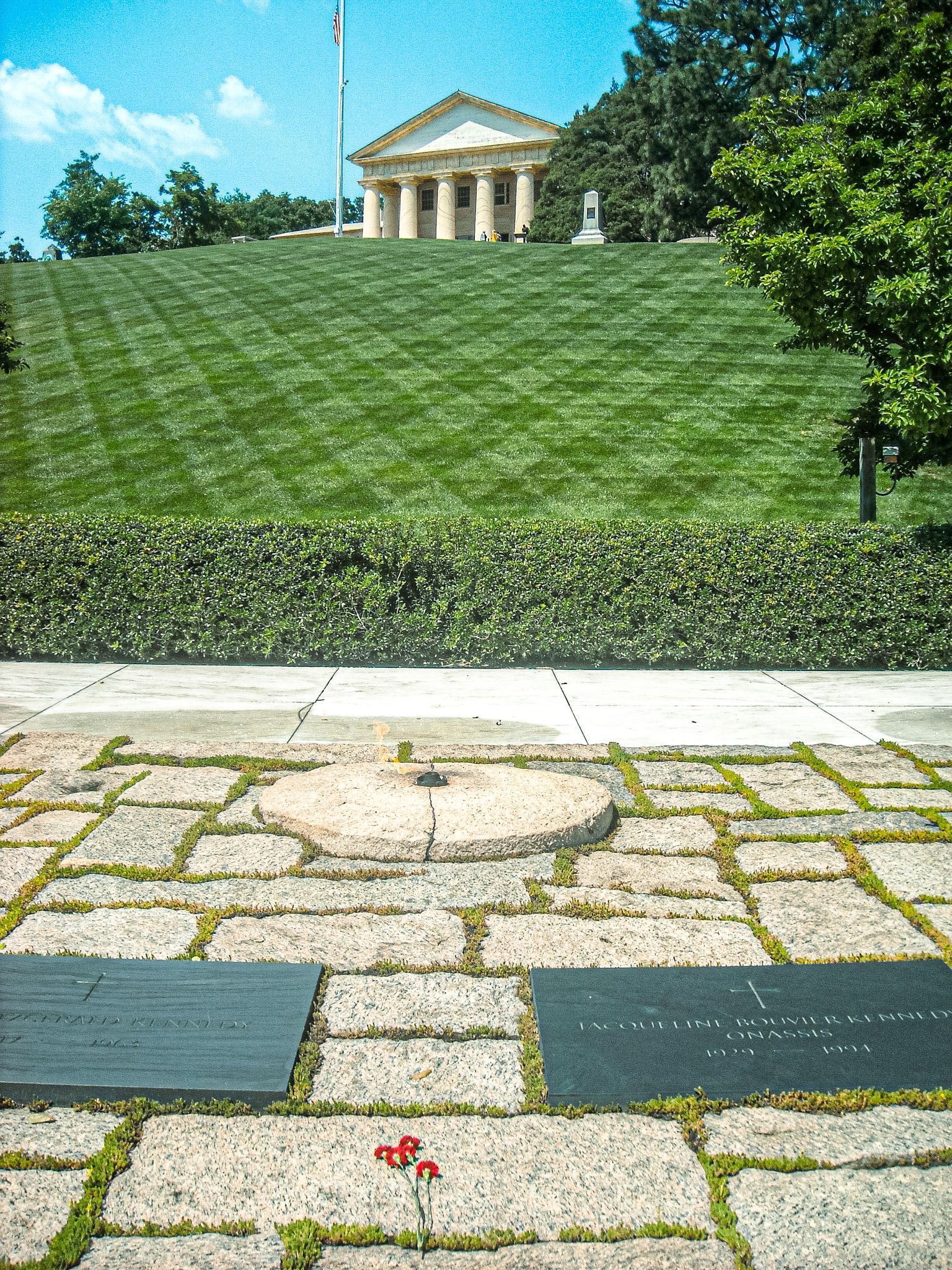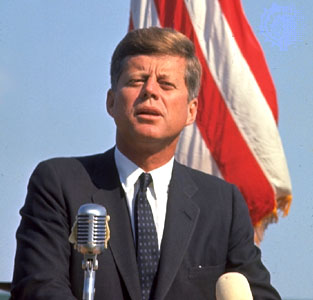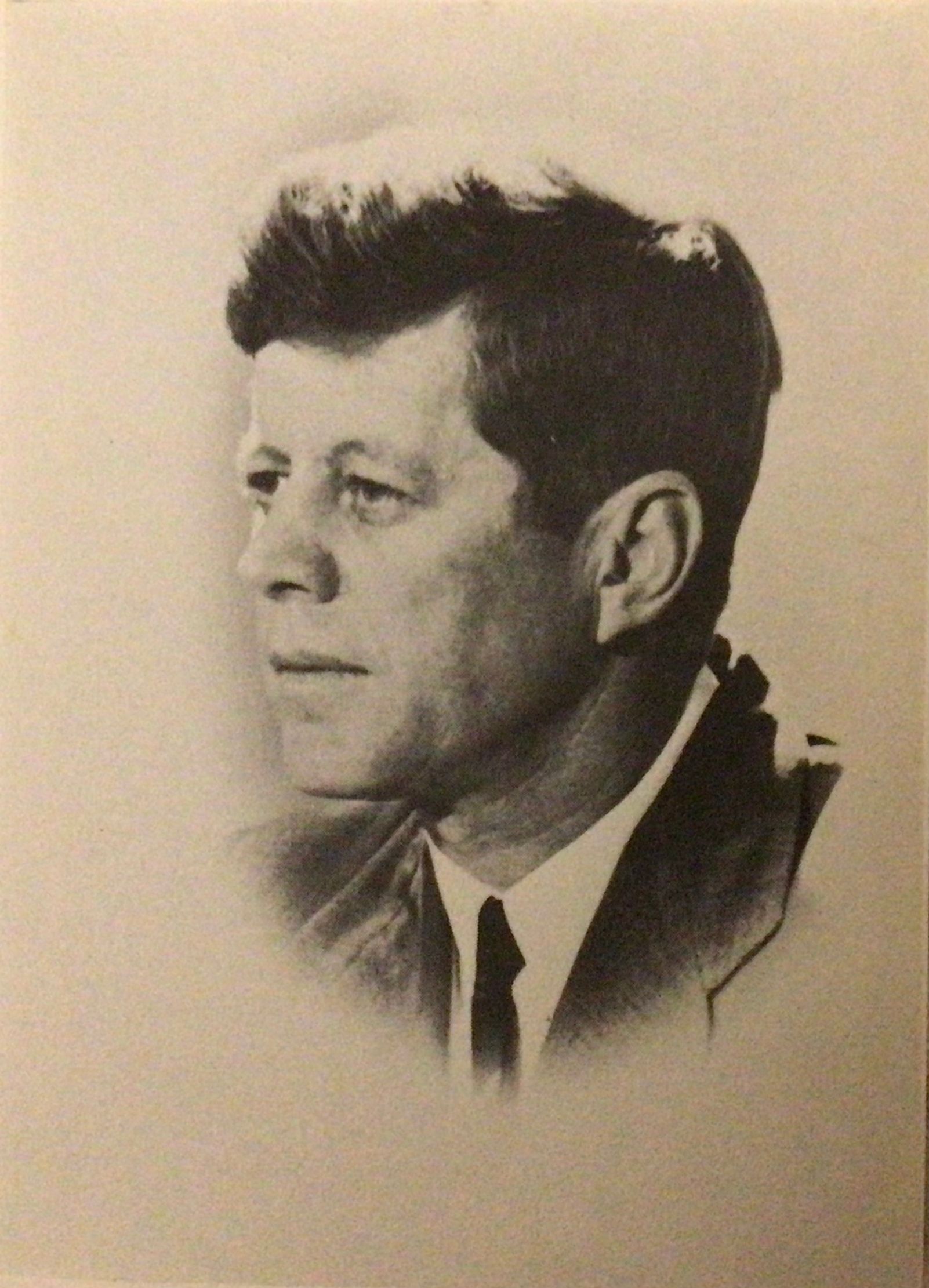35th United States President, U.S. Senator, U.S. Congressman, Pulitzer Prize-Winning Author. He was the older brother of U.S. Attorney General and U.S. Senator Robert F. "Bobby" Kennedy and U.S. Senator Edward M. "Ted" Kennedy. He was the youngest elected U.S. President and the first of the Catholic faith to hold the office. The second son of wealthy businessman Joseph Patrick Kennedy Sr. and Rose Fitzgerald Kennedy, he was born into a life of privilege but suffered from a variety of health ailments, including whooping cough, appendicitis, and scarlet fever. Joseph Patrick Kennedy taught his children to be competitive in every aspect of life but stressed the role of public service. Young Jack was educated at private schools, and after his father was appointed US Ambassador to England, he studied at the London School of Economics. Following his return to Massachusetts, he enrolled at Harvard University and majored in Political Science with an emphasis on International Relations while participating on the school's football and swim teams. He later acquired experience while working as a secretary for his father in England. After the United States entered World War II, he enlisted in the United States Navy. He rose to the rank of lieutenant and was commander of the PT-109. During a patrol off the Solomon Islands, the boat was rammed in two by a Japanese destroyer, resulting in the deaths of two crewmen. The remaining personnel were tossed into the water. Kennedy swam for four hours to a nearby island while towing an injured sailor by his lifejacket. Kennedy decided to swim out on his own in order to find help, and after several more hours in the water, he reached another island where he came in contact with local fishermen. He carved a message on a coconut and gave it to the fishermen, who forwarded it to the allies. Kennedy and his crew were soon rescued. The ordeal, however, further damaged an already weakened back, which hindered Kennedy for the remainder of his life. During the war, Kennedy's older brother Joseph "Joe" was killed in a plane crash. With Joe now gone, attention shifted to Jack to be groomed for a political career and the ultimate goal, the presidency. Recognized as a war hero, Kennedy ran for a local Democratic Congressional seat and won. In 1952, he was elected US Senator from Massachusetts, and in 1953, he married Jacqueline Lee Bouvier, the daughter of a wealthy stockbroker, 12 years Kennedy's junior. During the 1950s, the couple gained national attention, including an appearance on the Edward R. Murrow TV interview program "Person to Person." Kennedy's popularity in the Senate grew to the point where he was strongly considered to be a running mate for 1956 Democratic Presidential Nominee Adlai Stevenson. He received a Pulitzer Prize for his book "Profiles in Courage" (1957). However, for Kennedy, further health complications arose, including an ongoing battle with Addison's disease, which often sapped his strength and vigor. For his chronic back pain, he received regular injections of cortisone. In 1960, he launched his presidential campaign and promised a new chapter in America for a younger generation born in the 20th Century. His Republican challenger was Vice President Richard Nixon. Their TV debate became historic. While Nixon looked uncomfortable and unsure, Kennedy came off as confident and focused. It is widely believed that the debate influenced many to be in favor of Kennedy. The 1960 presidential election was decided by the narrowest of margins (a little more than 100,000 popular votes), with Kennedy as the winner. During his inauguration speech, he included the now-famous line, "Ask not what your country can do for you; ask what you can do for your country." Kennedy did not have to wait long for his first challenge. In April of 1961, tensions with Cuba's dictator, Fidel Castro, reached a breaking point. A plan was devised to liberate the country from Castro's ruling orchestrated by the Central Intelligence Agency (CIA). Kennedy approved of the operation. The result was a total disaster and became what is known as "The Bay of Pigs." He learned from his mistakes, and the following year, in October of 1962, a second situation with Cuba arose. The Soviet Union had begun to establish missile sites within Cuba directed toward the United States. The country faced a strong possibility of nuclear war with the Soviets. Over the next few days, several messages would go back and forth between Kennedy and Nikita Khrushchev. Kennedy made a televised speech about implementing a quarantine on Cuba until the bases were dismantled. The Soviets backed down and removed the sites. The event, which is now known as "The Cuban Missile Crisis," showed Kennedy's ability to safely guide the United States away from what could have been a world-ending war. The remainder of his time in office saw the Civil Rights Movement gain traction, a tense situation with Governor George Wallace of Alabama, who refused to let black students enter the University of Alabama, which resulted in the need to use federal troops and the decision to further military actions in Vietnam. Kennedy advanced the American space program in order to compete with the Soviets. Additionally, he established the Peace Corps. Fear of losing Southern support in the South because of his policies toward Civil Rights led Kennedy to go on a trip to Dallas, Texas. During a motorcade in downtown Dallas on November 22, 1963, accompanied by Mrs. Kennedy, Texas Governor John B. Connally, and his wife Nellie, Kennedy was fatally shot in the back of the neck and head. The country was thrown into a state of mourning. Over the next two days, his flag-draped casket would lie in state at the US Capitol. He was laid to rest at Arlington National Cemetery on November 25, 1963, and there is a cenotaph for him at St. Peter's Churchyard, adjacent to the grave of his sister, Kathleen. In the years since his death, details of alleged extramarital affairs surfaced, including encounters with movie star Marilyn Monroe and his close friend Lem Billings. Additionally, it is widely believed that Lee Harvey Oswald, the alleged assassin, did not act alone. Dallas nightclub owner Jack Ruby shot Oswald to death on live television two days after Kennedy's death. This added to the speculation of a conspiracy. No solid proof has ever supported such a theory. In spite of this, Kennedy remains one of the most popular presidents in American history.
35th United States President, U.S. Senator, U.S. Congressman, Pulitzer Prize-Winning Author. He was the older brother of U.S. Attorney General and U.S. Senator Robert F. "Bobby" Kennedy and U.S. Senator Edward M. "Ted" Kennedy. He was the youngest elected U.S. President and the first of the Catholic faith to hold the office. The second son of wealthy businessman Joseph Patrick Kennedy Sr. and Rose Fitzgerald Kennedy, he was born into a life of privilege but suffered from a variety of health ailments, including whooping cough, appendicitis, and scarlet fever. Joseph Patrick Kennedy taught his children to be competitive in every aspect of life but stressed the role of public service. Young Jack was educated at private schools, and after his father was appointed US Ambassador to England, he studied at the London School of Economics. Following his return to Massachusetts, he enrolled at Harvard University and majored in Political Science with an emphasis on International Relations while participating on the school's football and swim teams. He later acquired experience while working as a secretary for his father in England. After the United States entered World War II, he enlisted in the United States Navy. He rose to the rank of lieutenant and was commander of the PT-109. During a patrol off the Solomon Islands, the boat was rammed in two by a Japanese destroyer, resulting in the deaths of two crewmen. The remaining personnel were tossed into the water. Kennedy swam for four hours to a nearby island while towing an injured sailor by his lifejacket. Kennedy decided to swim out on his own in order to find help, and after several more hours in the water, he reached another island where he came in contact with local fishermen. He carved a message on a coconut and gave it to the fishermen, who forwarded it to the allies. Kennedy and his crew were soon rescued. The ordeal, however, further damaged an already weakened back, which hindered Kennedy for the remainder of his life. During the war, Kennedy's older brother Joseph "Joe" was killed in a plane crash. With Joe now gone, attention shifted to Jack to be groomed for a political career and the ultimate goal, the presidency. Recognized as a war hero, Kennedy ran for a local Democratic Congressional seat and won. In 1952, he was elected US Senator from Massachusetts, and in 1953, he married Jacqueline Lee Bouvier, the daughter of a wealthy stockbroker, 12 years Kennedy's junior. During the 1950s, the couple gained national attention, including an appearance on the Edward R. Murrow TV interview program "Person to Person." Kennedy's popularity in the Senate grew to the point where he was strongly considered to be a running mate for 1956 Democratic Presidential Nominee Adlai Stevenson. He received a Pulitzer Prize for his book "Profiles in Courage" (1957). However, for Kennedy, further health complications arose, including an ongoing battle with Addison's disease, which often sapped his strength and vigor. For his chronic back pain, he received regular injections of cortisone. In 1960, he launched his presidential campaign and promised a new chapter in America for a younger generation born in the 20th Century. His Republican challenger was Vice President Richard Nixon. Their TV debate became historic. While Nixon looked uncomfortable and unsure, Kennedy came off as confident and focused. It is widely believed that the debate influenced many to be in favor of Kennedy. The 1960 presidential election was decided by the narrowest of margins (a little more than 100,000 popular votes), with Kennedy as the winner. During his inauguration speech, he included the now-famous line, "Ask not what your country can do for you; ask what you can do for your country." Kennedy did not have to wait long for his first challenge. In April of 1961, tensions with Cuba's dictator, Fidel Castro, reached a breaking point. A plan was devised to liberate the country from Castro's ruling orchestrated by the Central Intelligence Agency (CIA). Kennedy approved of the operation. The result was a total disaster and became what is known as "The Bay of Pigs." He learned from his mistakes, and the following year, in October of 1962, a second situation with Cuba arose. The Soviet Union had begun to establish missile sites within Cuba directed toward the United States. The country faced a strong possibility of nuclear war with the Soviets. Over the next few days, several messages would go back and forth between Kennedy and Nikita Khrushchev. Kennedy made a televised speech about implementing a quarantine on Cuba until the bases were dismantled. The Soviets backed down and removed the sites. The event, which is now known as "The Cuban Missile Crisis," showed Kennedy's ability to safely guide the United States away from what could have been a world-ending war. The remainder of his time in office saw the Civil Rights Movement gain traction, a tense situation with Governor George Wallace of Alabama, who refused to let black students enter the University of Alabama, which resulted in the need to use federal troops and the decision to further military actions in Vietnam. Kennedy advanced the American space program in order to compete with the Soviets. Additionally, he established the Peace Corps. Fear of losing Southern support in the South because of his policies toward Civil Rights led Kennedy to go on a trip to Dallas, Texas. During a motorcade in downtown Dallas on November 22, 1963, accompanied by Mrs. Kennedy, Texas Governor John B. Connally, and his wife Nellie, Kennedy was fatally shot in the back of the neck and head. The country was thrown into a state of mourning. Over the next two days, his flag-draped casket would lie in state at the US Capitol. He was laid to rest at Arlington National Cemetery on November 25, 1963, and there is a cenotaph for him at St. Peter's Churchyard, adjacent to the grave of his sister, Kathleen. In the years since his death, details of alleged extramarital affairs surfaced, including encounters with movie star Marilyn Monroe and his close friend Lem Billings. Additionally, it is widely believed that Lee Harvey Oswald, the alleged assassin, did not act alone. Dallas nightclub owner Jack Ruby shot Oswald to death on live television two days after Kennedy's death. This added to the speculation of a conspiracy. No solid proof has ever supported such a theory. In spite of this, Kennedy remains one of the most popular presidents in American history.
Bio by: C.S.
Inscription
JOHN FITZGERALD KENNEDY
1917 — 1963
Gravesite Details
Interment Date: November 25, 1963
Family Members
Other Records
Advertisement
See more Kennedy memorials in:
Records on Ancestry
Sponsored by Ancestry
Advertisement

















